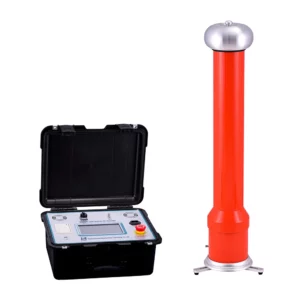In many industrial usage scenarios, our equipment often needs to be connected to the high-voltage current, especially the cables used in high-voltage wires. Then how can we ensure these elements cannot be breakdown by the high voltage. For fight out the ability to withstand voltage of these elements, we always utilize the high voltage dc tester to complete this test.
The reason for choosing the high voltage dc tester.
Insulation Testing:
This testing target is ensuring the elements’ insulation integrity. This testing needs high-voltage DC tester to apply a high voltage to the device to complete the target.
Dielectric Strength Testing:
The tester evaluates the ability of the insulation material to withstand high voltage without breakdown or failure. It applies a higher voltage than the normal operating voltage to the DUT to simulate extreme conditions and ensure safety and reliability.
The features of high voltage dc tester:
1.We can adjust the voltage flexibly. The high-voltage DC testers are capable to generate and deliver high voltages typically ranging from hundreds to several thousand volts. This function can ensure us to get the suitable voltage of our testing environment.
2.High-voltage DC testers are equipped with safety features such as voltage interlock, ground fault protection, overcurrent protection, and emergency shutdown mechanisms. All of these features could ensure the safety of operators and prevent electrical hazards. Furthermore, high voltage dc tester always uses the dc product by high voltage dc generator. It is worth mentioning that, a good high voltage dc generator is also a key to ensure the high voltage dc tester’s safe.
3.To ensure the results of the elements accurately, these testers always provide accurate and precise voltage measurements and insulation resistance readings. And these factors can help evaluate the quality and reliability of the insulation system.
4.Many high-voltage DC testers feature an intuitive user interface with a digital display, keypad, and menu-driven navigation for easy operation and programming of test parameters.
5.Our company product these High-voltage DC testers allowing the IEC, IEEE, UL, CSA, and other industry-specific standards. We can promise that all of these machines would comply with international standards and regulations governing electrical safety testing.
6.High-voltage DC testers are available in both portable and benchtop configurations, allowing for flexibility in testing applications ranging from field testing to laboratory environments.
7.For many operators, data logging is an important part which they will consider.
To satisfy the command, some advanced high-voltage DC testers offer data logging capabilities to record test results. Furthermore, they also could perform statistical analysis, and generate comprehensive test reports for documentation.

How to use the machine rightly?
The first step is reading the manual:
Before you are using the high-voltage DC tester, please thoroughly read the manufacturer’s manual and ensure that you are familiarizing yourself with its operation, safety precautions, and specifications.
The second step is inspecting the Tester:
Before each use, please inspect the tester if has any visible damage. Such as loose connections and signs of wear. In addition, we need to ensure that all components are in good condition. When we do these completely, we also need to ensure tester is properly calibrated.
Prepare the Test Setup:
We need to determine the test setup based on the specific application and the equipment or components which to be tested. Stable power source is a key part to ensure the testing successfully. So, we need to ensure that the tester is connected to a stable power source and all connections are secure.
Set the Test Parameters:
We need to accord the specifications of the equipment or components to set the test parameters on the tester. This includes selecting the voltage level, test duration, and any other relevant parameters.
Connect the DUT:
Carefully connect the device under test (DUT) to the tester using appropriate cables or probes. Ensure that the connections are secure and that there are no loose or exposed wires.
Disconnect and Shutdown:
After completing the test, carefully disconnect the DUT from the tester and power source. Turn off the tester and follow any specific shutdown procedures outlined in the manual.
Safety Cleanup:
Please ensure that the testing area is cleaned up and returned to a safe condition. Furthermore, we need to store the tester properly and every accessory in a secure location. This location must keep away from moisture, dust, and other contaminants.
Except the high voltage dc tester, we also have the ac dc tester. If you need to test some electrical machines which can use ac and dc, you can choose it.
